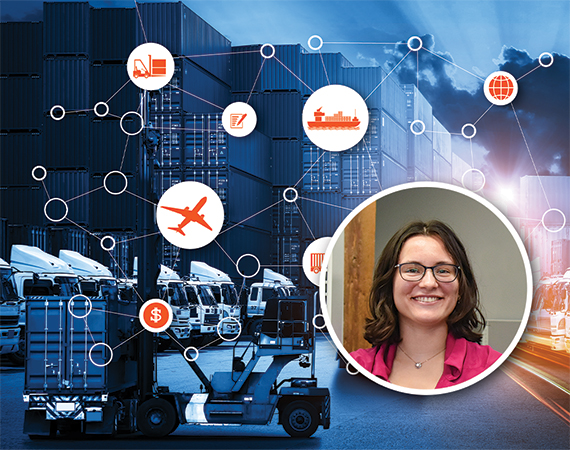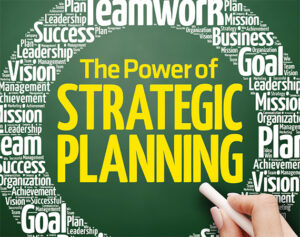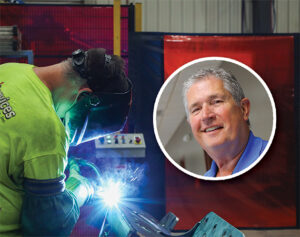Supply chain disruptions during the COVID pandemic were the stuff of business nightmares. Ships backed up at ports and manufacturers shut down for want of a tiny part — oh, to forget it all. And, you might be able to forget it, if COVID was the sole supply chain disruption business has endured in the past half decade. Supply chain disruptions take many forms and can strike companies large and small. Think hurricanes, blizzards, wildfires, cyber threats, the Russians invading Ukraine, a cargo vessel stuck in the Suez Canal, another container ship knocking down a bridge in Baltimore.
It’s one reason more companies are looking for ways to bring their supply chains closer to home. “Products that were low volume but highly complex were never good candidates for overseas manufacturing,” says Bob Kill, president and CEO of Enterprise Minnesota. Correcting that imbalance is behind a federal program to bring more manufacturing back to the United States and a new Enterprise Minnesota effort to discover how to make regional supply chains stronger, and deeper.
“We want to make supply chains more resilient,” says Amanda Baumgart, Enterprise Minnesota’s research and supply chain analyst. “Hopefully something like COVID doesn’t disrupt everything again. But it probably will.”
Understanding supply chains from the perspective of both OEMs and suppliers is the focus of Baumgart’s work for Enterprise Minnesota. She’s part matchmaker for OEMs seeking suppliers, part investigator into supply-chain struggles on both sides of the transaction, and always a student of better ways to do business. It’s a job to which she brings the enthusiasm of youth — she’s just 23 — and the intellectual underpinnings of an entrepreneurial education.
“When we work with companies, supply-chain issues tend to sit in the background,” says John Connelly, vice president of consulting for Enterprise Minnesota. “That OEMs don’t always know what their options for suppliers are is a long-standing problem. We have things to learn about how to help them, and we’re learning through Amanda’s research.”
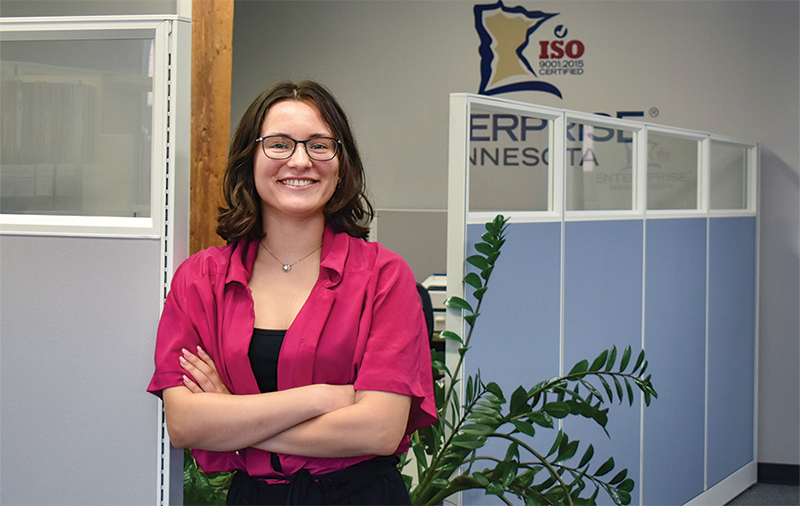
A national effort
Baumgart joined Enterprise Minnesota a year ago through a grant to locally implement a federal initiative called the Supply Chain Optimization and Intelligence Network (SCOIN). It’s part of the Biden administration’s Build America Buy America effort. The program asks the state-based Manufacturing Extension Partnership (MEP), such as Enterprise Minnesota, to respond to national supplier scouting requests. To do that, Baumgart is researching and analyzing the capabilities of state suppliers and the needs of OEMs. She is also developing a database of Minnesota companies and their capabilities and capacity to expedite connections between suppliers and OEMs.
In the past few months, about a dozen Minnesota manufacturers have been referred for jobs through Baumgart and the national scouting network, providing everything from 50-foot-long steel tanks to coconut coir mats for environmental remediation to injection-molded parts. Requests come from OEMs all over the United States, Baumgart says, many of which are developing a new product or considering switching suppliers. Requests may be for a part, a product, resources, or simply information.
“There’s usually something a little bit quirky about them,” she says of the requests. Part of her job is digging out the details of the requests, making it easier to identify appropriate suppliers among Enterprise Minnesota clients. Since 70% of Enterprise Minnesota’s clients are suppliers to OEMs, it’s a natural fit.
Baumgart is also adding more specific information to Enterprise Minnesota’s existing database of companies, everything from certifications to shipping methods. And, she’s in the midst of interviewing about 100 Minnesota companies — both suppliers and OEMs — to strengthen Enterprise Minnesota’s understanding of each and build better relationships between suppliers and OEMs. “This is a building block toward the services we’re going to offer in the future,” she says. “Part of my job is to highlight the resources we have with Minnesota manufacturers. Even if there’s not a sale made today, there’s still that opportunity that something may come of it later.”
Minnesota has a lot of OEMs, Connelly says. “When most people hear the term OEM, they think of car manufacturers — something really large. The fact of the matter is that any manufacturer who produces a product of their own design is an OEM. We have a lot of those.”
No matter the OEM’s size, finding suppliers closer to home can help them form deeper, long-term partnerships, he says. It can lower transportation costs, which is especially important with heavier or bulkier components. Having closer suppliers can also improve communication, reduce lead times, reduce risk, and increase flexibility.
“Sometimes OEMs are looking for a supplier who can build something for them and also help them engineer it,” Connelly says. “They know they need something but they don’t know what features they will need or the specific material elements. Their supplier can help them figure that out, and that increased communication helps both companies.”
The changing supply chain
“There’s been this buzzword of ‘reshoring,’” Kill says, “and I think it was just a buzzword until the last year and a half or two years.” But now, more OEMs are rethinking the types of work that are being sent overseas and are looking for suppliers within a time zone or two of their headquarters. “You really cannot beat the quality of Midwest manufacturers,” Kill says.
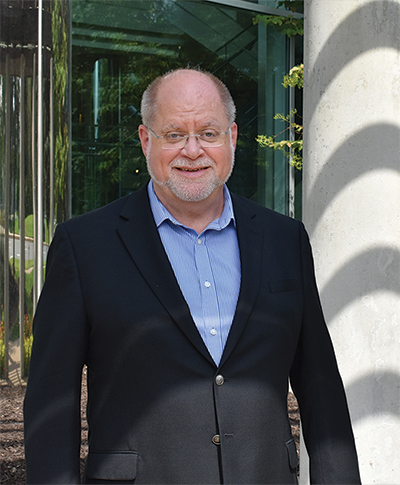
John Melbye, president of the Twin Cities chapter of the Association for Supply Chain Management, agrees that there has been a shift in thinking about supply chains. For example, the idea of reducing inventory as much as possible is being questioned, he says. “Inventory is a leverage point,” Melbye says. “If you have inventory, you can do whatever you want to do. If you don’t have inventory, you can’t.”
Successful companies now see their supply chain not as a cost but as a strategic advantage. The federal effort to enhance U.S. supply chains is a wise move, but will be a slow process, he says.
“Companies are trying to ‘near-source’ or ‘reshore,’ but we didn’t move everything overseas in two days,” Melbye says. “That took a decade or more, and to suggest we will move everything back by snapping our fingers is insane. It’s a longer-term game, and you’ve got to lay the groundwork.”
Digital tools make it easier to find new suppliers, but OEMs need to put due diligence into the process. The tools Enterprise Minnesota is bringing to build that bridge of awareness between those who have certain capabilities and those searching for those capabilities is a huge undertaking, he says.
“It’s not just about near-shoring. These are competitive advantages if we set up the framework to find suppliers or for OEMs to find us,” Melbye says. “That’s going to be a benefit that long outweighs the post-pandemic reaction.”
Baumgart’s conversations with OEMs have revealed several areas they are concerned about.
Quality. OEMs typically are looking for suppliers with a quality program in place. ISO certification may not be necessary, but evidence of a quality process that ensures OEMs the supplier will produce parts to specification and meet delivery dates is mandatory. “Delivery dates have jumped out in a lot of our conversations,” Connelly says, “but often they are defined differently.”
Capacity. Many OEMs saw significant growth during and after the pandemic and are hoping to continue that trend. Having suppliers with the capacity to grow along with them is a key concern, Kill says.
Automation. A 2023 survey from consulting firm Ernst & Young found that about half of the supply chain executives surveyed expected that by 2035 most of their supply chain would be automated, including the use of warehouse robots, driverless forklifts, and delivery by drone. “You want to be automated. You want to be lights-out,” Baumgart says, but that presents challenges for high-mix/low-volume suppliers. Still, she thinks more processes could be automated to make suppliers more competitive. “This is an unharvested opportunity for suppliers,” she says.
Partnerships. Baumgart’s supply chain certification emphasized the value of partnerships, within an organization and within the supply chain. For manufacturers, understanding how their partnerships work — are they merely transactions or are the companies invested in each other — is important, she says.
What’s next?
Baumgart expects to finish her interviews with leaders and her data analysis later this year. Her position was funded by a two-year grant, and she’s hoping to develop new ways to assist suppliers and OEMs.
“We’re still in the early stages,” Kill says of Baumgart’s interviews, “but the findings we’re seeing are validating things we thought we knew.”
“There’s a lot of methodology behind managing supply chains,” Connelly says. “Continuous improvement is something we are really good at. To be able to take those skills and add to them what can happen in sourcing is the ultimate goal for us.”
Says Baumgart, “We’re looking to find that one problem where we can provide a solution that will help manufacturers. We understand disruption will be more frequent, and we want to be prepared for it.”
Return to the Fall 2024 issue of Enterprise Minnesota® magazine.
